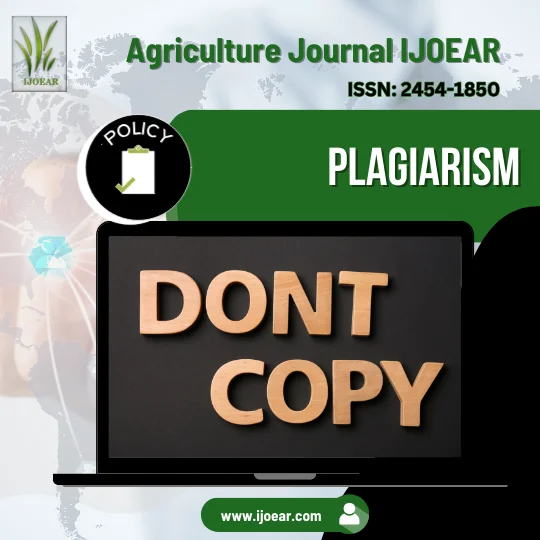 October 2025 Articles
October 2025 Articles Impact Factor: 6.69
Impact Factor: 6.69  Submit Article
Submit Article 
|
Citation Indices
|
All
|
Since 2020
|
|
Citation
|
6164
|
5117
|
|
h-index
|
31
|
29
|
|
i10-index
|
201
|
165
|
|
Acceptance Rate (By Year)
|
|
|
Year
|
Percentage
|
|
2024
|
11.09%
|
|
2023
|
15.23%
|
|
2022
|
12.81%
|
|
2021
|
10.45%
|
|
2020
|
9.6%
|
|
2019
|
14.3%
|
|
2018
|
17.65%
|
|
2017
|
16.9%
|
|
2016
|
22.9%
|
|
2015
|
26.1%
|

The International Journal of Environmental and Agriculture Research (IJOEAR) is committed to maintaining the highest standards of integrity and originality in published research. As a peer-reviewed, open-access journal, IJOEAR emphasizes the importance of ethical publishing practices and strongly discourages any form of plagiarism or unethical behavior in academic writing.
Plagiarism is defined as the unethical act of copying someone else’s ideas, processes, results, or words without proper acknowledgment. Self-plagiarism occurs when an author uses substantial portions of their previously published work without citation. IJOEAR is dedicated to ensuring all submissions are free from plagiarism, as this practice undermines the credibility of research and the integrity of the journal.
IJOEAR categorizes plagiarism into the following types:
All submitted manuscripts are screened for plagiarism using advanced software like Turnitin or similar licensed tools. Manuscripts with plagiarism beyond acceptable limits are rejected outright.
If plagiarism is identified post-publication, the journal will conduct an investigation. Based on the findings, appropriate actions, including retracting the paper, contacting the authors’ affiliated institution, or marking the paper with a plagiarism notice, will be taken.
To uphold ethical standards, IJOEAR follows a strict plagiarism policy. If plagiarism is suspected:
The following actions may be taken against authors found guilty of plagiarism:
IJOEAR encourages authors to ensure their work is original, properly cited, and adheres to ethical publishing practices. By maintaining these standards, the journal aims to contribute to the credibility and authenticity of academic research.
For any queries or additional information, authors can contact the editorial team via email at info.ijoear@gmail.com or info @ijoear.com.com .